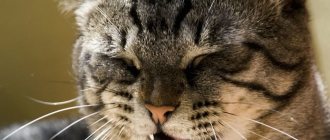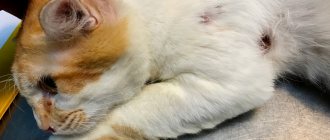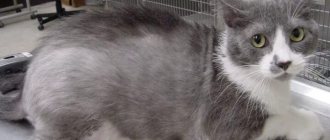11847Pavel
2
There are many myths about cats. There are no less misconceptions about their health. Even experienced owners do not always know what the cat’s condition and the temperature of individual parts of its body should normally be. It is believed that the nose should be wet and cool. And if a cat has a hot nose, it means he is sick and needs help. Unfortunately, the pet cannot tell us how it is feeling. A cat's nose can be an excellent indicator of changes in health.
Features of thermoregulation
First of all, never forget that, as nature intended, a cat’s normal body temperature is always almost 2° higher than that of a human. Sometimes this causes the owner to feel as if the pet’s nose is slightly warm, while the cat itself may feel great. You also need to remember that all thermoregulation mechanisms in cats work very clearly. The temperature on certain parts of their body may change throughout the day, and this is normal. If a cat has a hot, wet nose, and after 30-40 minutes it becomes completely normal (warm or cool), this means that there is no reason to worry. Most likely, the warming of the nose was caused by non-fatal factors for the cat's life, which increased the overall temperature. At the same time, the thermoregulation mechanisms independently coped with this problem.
Signs of illness
If owners notice a hot nose on their cat, they should be concerned as soon as possible and make an appointment with a doctor when one of the following symptoms is added:
- the animal does not drink water for a long time;
- the cat refuses to eat;
- avoids owners, hides, does not want to play;
- shows aggression, runs around the apartment, behaves irritably;
- the animal, on the contrary, becomes apathetic and falls into melancholy;
- there are signs of a cold: sneezing, red eyes;
- Fluid flows from the nose and discharge occurs.
A tick on a cat: bitten, what to do, is it dangerous?
Important! Such signs, along with elevated ear temperature, may indicate a painful condition that requires veterinary intervention.
Viral infection
If the cat's immune system is fighting an infection, its temperature may rise above normal. If your cat has warm ears, there may be other signs of a viral infection: lethargy and decreased appetite.
Viral diseases include acute pathological changes associated with the presence of microorganisms in the blood of an animal. Pathogenic organisms cause various serious consequences that significantly undermine the health of the pet.
Since viral diseases are inflammatory processes, the pet’s body fights by raising the temperature, which manifests itself in the form of hot ears.
Such infections may include: rabies, panleukopenia, rhinotracheitis, calcivirosis, etc.
To alleviate the condition, wrap the animal in a damp soft cloth so that it stops burning.
Viral infections are dangerous for a small kitten. If you have a weak immune system, you cannot do without the use of special medications.
Viral infection causes high fever in cats
Important! Treatment is permissible only on the recommendation of a veterinarian.
Infectious diseases
Ear infections are a common cause of hot cat ears. An ear infection occurs when the cat scratches its ears and tries to rub them on the carpet or corners of furniture. This behavior can lead to inflammation, redness and local fever. Other warning signs of an ear infection may include head shaking, excessive wax, and foul odor from the ears. In this situation, treatment is required as soon as possible to give the cat a chance to get relief before it suffers damage to its eardrums.
Hot ears plus discharge or blood from the ears are serious signs that require a visit to a qualified veterinarian, who will take the earwax for examination to determine the source of the problem and determine the best course of treatment. Various microorganisms can cause ear infections, and only a veterinarian can accurately identify which ones are causing the impact in a particular case.
Note! Among possible infectious diseases, the most common is otitis media.
Signs of this disease:
- the cat is hot to the touch;
- squelching sounds from the ears;
- wet ear discharge;
- the pet does not allow you to touch the sore ear;
- Meows loudly when there is acute pain.
Urgent veterinary care is required in a specialized clinic. The doctor’s recommendations for otitis media must be followed exactly to increase the effectiveness of the procedures.
Important! Infectious diseases in a kitten are more pronounced, since the body is too weak to resist.
Intestinal disorders
An increase in ear temperature may be associated with certain intestinal disorders in the cat. They are characterized by inflammation of the small intestine and are called enteritis. The reasons can be different: viruses, bacteria, protozoa.
Main symptoms of intestinal disorders:
- increased temperature not only of the ears, but also of the whole body;
- loose stools;
- general weakness;
- vomit;
- flatulence;
- dehydration;
- colic;
- refusal to eat;
- heart failure.
Possible intestinal disorders in cats:
- rotavirus enteritis;
- coronavirus peritonitis;
- panleukopenia;
- salmonellosis;
- campylobacteriosis;
- Tizzer's disease.
Intestinal disorders in cats also cause a rise in temperature
Treatment should be prescribed exclusively by a veterinarian.
Injuries, hematomas
Examination of the auricle shows redness and signs of inflammation. Such signs are a consequence of ear hematoma. A hematoma is damage to blood vessels that does not show signs of external bleeding.
If a hematoma is present, the symptoms are:
- the pet is actively scratching its ear;
- rubs his head on the floor and objects;
- there is no discharge from the auricle (for example, as with otitis media).
To eliminate it, it is enough to use a special medicine prescribed by a veterinarian to relieve the hematoma.
Bladder stones
Even bladder stones can be one of the reasons for increased ear temperature. The disease is called cystitis. Accompanied by inflammation of the mucous membrane of the bladder due to infection or the presence of stones.
To make such a diagnosis, a thorough examination is required through laboratory tests of urine, blood, cytoscopy, and ultrasound of the abdominal cavity.
Important! Each specific case requires an individual approach to treatment tactics.
Cold
Colds are common not only to people, but also to pets for the same reasons and factors as in humans. The main symptoms of cat colds are:
- runny nose;
- sneezing;
- chills with an increase in general temperature, including the temperature of the ears and nose;
- lack of appetite;
- apathy;
- arrhythmia;
- cough;
- sleep disorders.
Important! Colds in cats, just like in humans, present with similar symptoms. It is necessary to monitor your pet's immunity, especially in cold seasons. Treatment may be prescribed by your doctor depending on your pet's condition and symptoms.
Ear mite
One of the most common problems cats face involves insect and mite infestations. Fleas and ticks feed on cats' skin, and ears are especially sensitive. In addition, they do not have as much fur as other parts of the body.
The most common mite that appears in cat ears is Otodectes cynotis. It is the size of a grain of salt. The mite becomes active, laying eggs in the cat's ear canal. After three days, new individuals hatch from them, which after 21 days are ready for reproduction. They can be very irritating to your cat, causing her to want to scratch her ear constantly.
Ear mites are parasitic arachnids that burrow inside your cat's ear canals and feed on the tissue and debris in her ears. Scratching causes the ears to become inflamed, which may cause the ear to feel hot to the touch. In addition to intense scratching and hot ears, you may notice excessive amounts of earwax. It resembles coffee crumbs. Prolonged infection and lack of treatment can lead to a secondary ear infection.
Does ear mite require le?
Should I worry?
In fact, cats are such vulnerable and delicate creatures that many everyday factors can provoke a short-term increase in temperature or cause their nose to warm up. Answers to the question “why does a cat have a hot nose?” there may be several:
- the pet is sleeping or has just woken up, and after it has warmed up in its sleep, its temperature is slightly elevated;
- the cat experienced stress (the appearance of another pet in the house, moving to a new place, someone loudly shouted at him);
- the animal was scared of something (loud noise, barking dog, vacuum cleaner, etc.);
- the furry friend showed too much activity, played, jumped, etc.
Why might a cat have a hot nose?
Popular advice says: to determine whether a cat is healthy, you first need to touch its nose. If it is cold, wet, clean inside and there is no mucus in it, then health is normal. Why does the nose get warm and dry?
Since the “temperature sensor” of cats is very sensitive to a variety of external factors, temperature fluctuations are rather the norm for it.
Here are some reasons for a warm nose:
- The pet just recently woke up - naturally, in her sleep she covered herself with her paw or hid her muzzle in her warm fur, so her nose was warm and became a little hotter than usual.
- The cat has returned from a walk - the temperature difference from cool street air to warm indoor air helps to warm the animal, including the warming up of the nose.
- The fluffy beauty moved a lot , frolicked, played outdoor games - just like in people, with increased physical activity, animals’ body temperature rises.
- A sharp fright - a dog crept up, household appliances made noise, the TV suddenly turned on and other unpleasant factors.
- Experienced severe stress has a longer lasting effect than momentary fear. This could be a change of place of residence, diet, change of owners, as well as raising your voice to the cat. When undeservedly punished, cats also get offended and then experience what happened very painfully.
The cat has a hot nose: what to do?
First of all, of course, you should not panic. If the pet has normal ears, behaves in the usual way, eats and drinks water, remains active and mobile, then you just need to carefully observe the animal over the next few hours. Most likely, this symptom will go away on its own.
If the owners notice a hot nose on the cat, they should worry and get to the veterinarian as soon as possible in cases where at least one of the following symptoms is added to this:
- the animal does not drink water for a long time;
- the cat refuses to eat;
- avoids owners, hides, does not want to play, does not go into arms;
- shows aggression, runs, rushes around the apartment, behaves irritably;
- the animal, on the contrary, becomes apathetic and falls into melancholy;
- signs of a cold appear: sneezing, eyes turn red;
- Fluid flows from the nose and discharge appears.
Is the cat or cat hot?! Reasons for rising temperature
The normal body temperature of a cat is 38-39.5°C. For a person, this temperature indicator is on the verge of critical. Therefore, touching a cat and feeling that the cat is hot
, the owners begin to panic.
Don’t get nervous right away; first, measure your pet’s temperature - this means that the cat is hot
, but for him the temperature is within the normal range.
Also the cat just has a hot nose
, in the absence of any other symptoms, is by no means an indicator of ill health.
The cat has just woken up; in a few minutes the temperature balance will be restored. The animal is scared or nervous; stress is a common reason why a cat is hot.
The heat caused by these reasons, after a short time,
the cat's hot nose
will return to normal temperature.
Symptoms of fever in cats and kittens
But if the thermometer shows over 39.5°C, and the cat has hot ears and a dry nose,
There are reasons for concern, especially if you have symptoms such as:
- the cat refuses food and water;
- general lethargy, drowsiness;
- the cat's ears are hot
, red, swollen, with an unpleasant odor; - hides from the light, from hands, behaves inappropriately;
- the cat's nose is hot and dry
, with dried purulent crusts; - signs of a cold (sneezing, coughing, runny nose, eyes).
Explanation why the cat is hot,
in this case, there can be one thing - there is an inflammatory process in the body.
If the cat has a hot nose and ears
with swelling, redness, dark plaque in the ears with an unpleasant odor - infection with ear mites can be assumed.
Otitis, which accompanies this parasitic disease, explains why the cat has hot ears
- the inflammatory process in them will not necessarily raise the general temperature. The increase in temperature can also be local, directly in the areas of inflammation.
The cat has hot ears
There are also other reasons:
- head and ear trauma,
- infectious or viral disease;
- urinary tract infection, intestinal disorder, etc.
How to take your pet's temperature
You should not postpone a visit to the doctor in cases where the cat has a hot nose for a long time and at the same time he has a lack of appetite and apathy. But in order to understand whether a hot nose really signals us about the temperature and whether it is worth exposing the cat to stress by taking it to the clinic for an unnecessary examination, you can measure the temperature at home, on your own.
In cats, this is done basally (that is, through the anus). Few cats will accept this owner's idea with enthusiasm, and you need to be prepared for the fact that the animal will resist and will not sit quietly for 5 minutes with a thermometer in its butt. Therefore, it is advisable that the procedure be carried out by 2 people, one of whom could hold the furry patient well at all times. In this case, it is desirable that the thermometer body be plastic and not glass.
We must remember that the body temperature of our tailed friends is several degrees higher than that of humans. So values around 38°-39° are acceptable for cats. But a temperature above 39° should be a signal that it’s time to show your pet to the veterinarian.
What can cause hot ears in a cat?
- In a state of excitement from the excitement of the game. This is the case when you play with your pet and he experiences emotional stress.
- When he hunts or defends himself.
- Ears may be hot after your pet wakes up. Don't panic.
- There are many times in your cat's life when he may experience stress. In these cases, his ears become hot.
- If the room is stuffy and the air temperature reaches +25 degrees or higher, then this may be one of the reasons why the cat has hot ears.
Answer: In some cases, hot ears in a cat are considered normal if the nose remains warm and moist. The pet has not lost its appetite and is active.
But if the pet has become lethargic, the nose is dry and hot, has lost its appetite, shakes its head, rubs its ears with its paws, then this may be a consequence of a disease caused by ear mites. Otodectosis is an ear mite that parasitizes the ear of an animal.
Examine your pet's ears:
- If signs of suppuration are visible
- Unpleasant smell
- Color change
- Liquid oozing
- The cat rubs its head on objects
- The head is constantly tilted to one side
These may be symptoms of ear mites. A trip to the vet is necessary.
Treatment for ear mites in cats
Upon examination, the veterinarian will identify a severely clogged ear canal that will need cleaning. Since inflammatory processes occur in the auricle, alcohol-containing liquids should never be used.
How to treat ear mites in animals
Most likely, the doctor will use Otifri veterinary ear cleaning lotion, or a 3 percent solution for external use of hydrogen peroxide. Which is well suited for treating wounds from purulent accumulations. After cleaning, an anti-mite medicine is instilled; the choice is quite varied: Oritsin, Bars, Ordermil, Amitrazine, Otoferonol, Tsipam, Akromectin, Frontline, Amidel-gel, Surolan, Amit Forte. It all depends on what is available at the clinic. Aversectin ointment may be available.
The cat will be treated according to a specially prescribed regimen. The doctor will decide what will be included in the full course. Self-treatment can cause intoxication and other serious consequences associated with incorrect dosage. After completing treatment, return to the clinic so that the doctor can diagnose the improvement or cure of your pet.
Advice for caring owners
Many of us, loving our cats madly, noticing their hot nose, immediately run to the computer and start looking for advice on various forums on what to do. Having read the advice of various “expert breeders”, the owners risk only aggravating the condition of their furry friend. You can read absolutely ridiculous advice on the Internet, for example: pour a teaspoon of vodka into the cat’s mouth, pick her some grass along the road, mix an Aspirin or Paracetamol tablet into her food.
Such methods, especially with the use of alcohol, can undermine the health of even an absolutely healthy animal.
No matter how great the temptation may be to “save” your sick tailed friend on your own, remember that an animal, just like a person, should only be prescribed any drug by a doctor. If a cat shows symptoms of a real illness, find the money, time and show it to the veterinarian, because the most important thing is not to harm the animal with your care.
Characteristics of a healthy nose in a cat
The ideal cat's nose should be moist and slightly cool. This is explained by the fact that cats are natural predators and the process of evolution has hardly changed their attitude towards hunting prey that is accessible to them in size. A cat's nose is designed differently than a human's. The cat's olfactory organ is capable of retaining odors that interest the animal, filtering them, and even separating them according to importance. A moist and cool nose better detects odors and allows the cat to track its prey in dense thickets or at night. Moisture on a cat's nose appears when the cat licks it or is the result of the action of special glands that secrete liquid.
Sometimes, you may notice that when a cat is sleeping or has just woken up, its nose is somewhat dry and hot (warm) to the touch. This is the norm. The animal does not get sick at all and its nose soon becomes moist and cool. If, however, the cat’s nose does not return to its “working” state for a long time, the animal is inactive, depressed, and eats poorly, then this should already cause concern.
Signs of disease in cats
High fever in a cat
There is no need to worry in advance if your pet has a hot and dry nose. The main reasons to pay attention to are:
- Refusal of water and food.
- Cough and runny nose.
- Heat.
- Dyspnea.
- Profuse salivation.
- Bloody discharge.
- Diarrhea, vomiting, problematic urination.
- Hair loss or changes in fur color.
Unusual behavior also indicates changes in your pet's health, such as aggression, lethargy, or anxiety. If these signs appear, it is necessary to urgently show the animal to a specialist.











